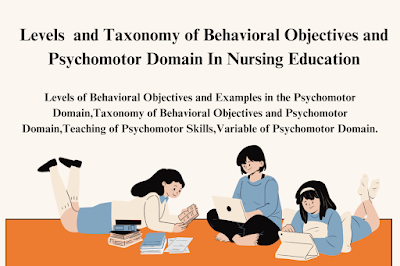The Levels and Taxonomy of Behavioral Objectives and Psychomotor Domain In Nursing Education. In nursing education, psychomotor objectives focus on the development of physical skills and movement.
The Levels and Taxonomy of Behavioral Objectives and Psychomotor Domain In Nursing Education
Bloom’s Taxonomy divides learning objectives into three areas: cognitive, affective, and psychomotor. The psychomotor area addresses the development of motor skills, manipulation, and coordination. Simpson’s Taxonomy is another popular taxonomy for the psychomotor domain and describes categories such as perception, set, and controlled response.
- Perception Level: Ability to use sensory cues to guide physical tasks.
- Example: “After a teaching session on aspiration precautions, the caregiver will describe the correct positioning to prevent choking during meals.”
- Set Level: Readiness to take action based on mental, physical, or emotional readiness.
- Example: “After a demonstration, the patient will express readiness to change their leg dressing using the correct procedural steps.”
- Guided Response Level: Ability to perform a skill under guidance, possibly with some errors.
- Example: “After watching a video on breast self-examination, the patient will perform the exam on a model with 100% accuracy.”
- Mechanism Level: Proficiency in performing a task with a certain degree of confidence and less conscious effort.
- Example: “After practicing, the patient will demonstrate proper crutch use, including the three-point gait technique.”
- Complex Overt Response Level: Mastery of complex tasks with precision and speed.
- Example: “After three teaching sessions, the patient will use crutches proficiently while navigating stairs, a car, and the bathroom.”
- Adaptation Level: Ability to adapt a skill to new circumstances.
- Example: “After training, the patient will modify their grocery list to replace unhealthy food items with healthier alternatives.”
- Origination Level: Creation of new motor skills in response to a problem or need.
- Example: “After simulation training, parents will recognize and respond appropriately to signs of respiratory distress in a child with asthma.”
Taxonomy of Behavioral Objectives and Psychomotor Domain
Dave’s (1970) taxonomy for psychomotor learning focuses on developing motor skills through muscular and neuromuscular coordination. This progression occurs over time through frequent use and refinement of skills. The taxonomy emphasizes accuracy in skill performance rather than speed, and it includes the following levels:
- Imitation
- Manipulation
- Precision
- Articulation
- Naturalization
These levels mirror the stages of mastering a motor skill, starting with observing and imitating and advancing to performing with high skill and automaticity.
Teaching of Psychomotor Skills
Teaching psychomotor skills requires a focus on demonstration and practice. Methods include:
- Demonstration: Instructors show learners how to perform a task.
- Return Demonstration: Learners practice the skill under supervision.
- Simulation: Realistic scenarios help learners practice in a controlled environment.
- Self-Instruction: Learners independently use resources like videos, models, or diagrams to master a skill.
Key considerations when teaching psychomotor skills include separating skill practice from cognitive discussions and avoiding multitasking between motor and cognitive domains. For example, avoid asking cognitive questions while the learner is actively performing a skill.
Variables in the Psychomotor Domain
The following factors affect how quickly and effectively learners acquire psychomotor skills:
- Readiness to Learn: Motivation directly impacts the effort and success of learning.
- Past Experience: Familiarity with related tasks speeds up the learning process through the transfer of learning.
- Health Status: Physical or emotional conditions can affect the ability to learn and perform tasks.
- Environmental Stimuli: Distractions or overly stimulating environments can hinder skill acquisition.
- Anxiety Level: High anxiety interferes with coordination and concentration, making it difficult to perform complex motor tasks.
- Developmental Stage: Age-related differences in motor, cognitive, and psychosocial abilities influence the rate and success of skill acquisition.
- Practice Session Length: Short, frequent practice sessions with rest periods are effective for early stages of skill learning.
Summary
The psychomotor domain in nursing education emphasizes learning motor skills essential for clinical practice. Teaching strategies such as demonstration and practice are essential for skill acquisition, and variables like readiness to learn, anxiety, and past experience impact how effectively learners develop these skills. Psychomotor learning integrates cognitive understanding and affective attitudes, making it an essential component of nursing education.
Levels and Taxonomy of Behavioral Objectives and Psychomotor Domain In Nursing Education
Levels and Taxonomy of Behavioral Objectives and Psychomotor Domain In Nursing Education
Levels and Taxonomy of Behavioral Objectives and Psychomotor Domain In Nursing Education
Read More:
https://nurseseducator.com/didactic-and-dialectic-teaching-rationale-for-team-based-learning/
https://nurseseducator.com/high-fidelity-simulation-use-in-nursing-education/
First NCLEX Exam Center In Pakistan From Lahore (Mall of Lahore) to the Global Nursing
Categories of Journals: W, X, Y and Z Category Journal In Nursing Education
AI in Healthcare Content Creation: A Double-Edged Sword and Scary
Social Links:
https://www.facebook.com/nurseseducator/
https://www.instagram.com/nurseseducator/
